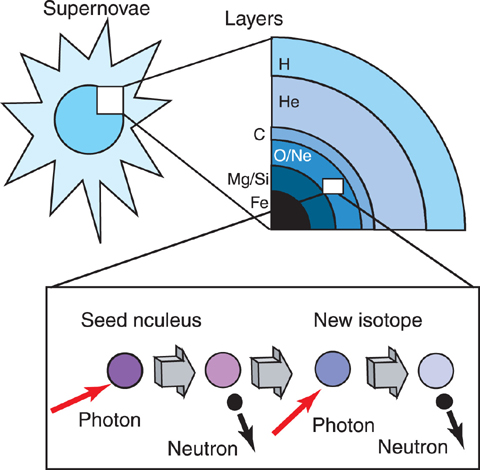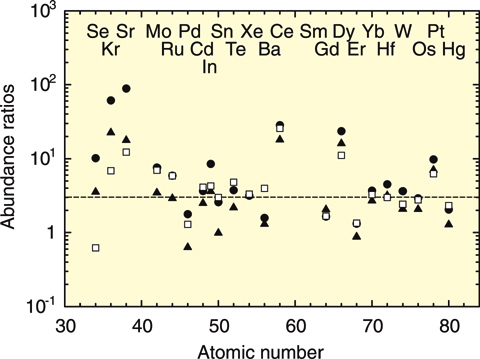
Fig.4-16

Fig.4-17
It has been well known that about 99% of elements heavier than the iron group were synthesized by neutron-induced reaction processes before the formation of the solar system. However, twenty-seven isotopes, so-called "p-nuclei", can not be synthesized by the neutron-induced reaction processes. To account for the astrophysical origin of the p-nuclei, a photodisintegration reaction process in supernova explosions (γ process) has been proposed (Fig.4-16). Massive stars that are at least eight times heavier than our sun may have supernova explosions in the last evolutional stage. In such explosions, new isotopes are produced by the photodisintegration reactions with high energy. We discovered an empirical law in the solar system, isotope ratios of a p-nucleus and a seed nucleus thereof that is heavier than the p-nucleus by two neutrons are almost constant. This law is the evidence that the most probable origin of the p-nuclei is the γ process.
There have been many stars born with various astrophysical conditions such as mass and metalicity. Our solar system was born from an interstellar medium, whose compositions originated from many stellar nucleosynthesis episodes under various astrophysical conditions. The question what type of stellar nucleosynthesis dominantly affected individual isotopes of the solar system materials has remained.
To understand the mechanism of the γ process, we calculated nucleosynthesis models of supernovae under various astrophysical conditions such as mass, metallicity, and explosion energy (Fig.4-17). The calculated results showed that the abundance ratios of a p-nucleus to its seed nucleus are almost constant over a wide region of atomic number, even under different astrophysical conditions. Why is there such a universality which is independent of the astrophysical conditions ?
The mass of the γ process layer in a progenitor depends on the explosion energy and mass. Because peak temperature of the layer is, however, almost constant and independent of the explosions energy and mass, the photodisintegration reaction rates are almost constant. Therefore, the empirical law that the abundance ratios of nuclides are almost constant over the wide region holds for materials produced by individual nucleosynthesis processes. The composition of the solar system is the average of many different stellar products and hence this empirical law applies.